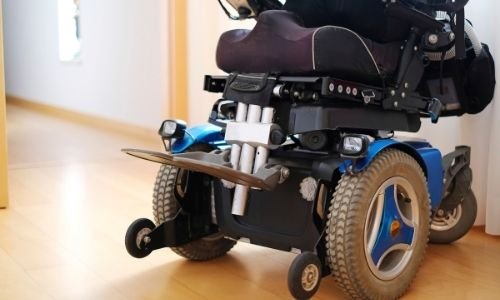How Does an Electric Wheelchair Work?
Electric wheelchairs, also called power wheelchairs or motorized wheelchairs, differ from manual wheelchairs in that they propel themselves, but how does an electric wheelchair work? If you or someone you know uses an electric wheelchair or you're simply curious, familiarizing yourself with the parts and models of electric wheelchairs will help you better understand and appreciate these mobility-enhancing machines.
Early Power Wheelchair Design
The first motorized wheelchairs were designed in the early 1900s but demand didn't pick up until after World War II. The earliest design was similar to a folding manual wheelchair with the addition of a motor, drive belt, and pulleys powered by a lead-acid battery.
The user would sit in the sling-style seat and move a joystick to go forward, backward, left, and right. These electric wheelchairs did not offer much in the way of postural support but fulfilled the function of increasing mobility.
Modern Power Wheelchairs
The motorized wheelchair we know today is built with two separate parts: a power base and a seating system. The American National Standards Institute (ANSI) and the Rehabilitation Engineering and Assistive Technology Society of North America (RESNA) set quality standards for power and electric wheelchairs.
If you are thinking of buying or renting a power wheelchair, a mobility specialist at Mobility Plus Colorado can explain the specifications of each model and what those features enable the user to do. We serve customers in the Denver area and throughout the state.
Power Base
The power base sits under the seating system and consists of a motor, battery, and wheels. The power base is the main feature that differentiates a power wheelchair from the earliest electric wheelchairs.
Motor
A limited number of electric wheelchairs today continue to use an indirect drive system with a drive belt and pulleys to make them move. However, most electric wheelchairs (and all power wheelchairs) have a gearbox instead.
The motor can be either a 2-pole or 4-pole motor: 2-pole motors are the most common for lightweight folding electric wheelchairs, and 4-pole motors are the most common for full-size and heavy-duty power wheelchairs.
Battery
Electric wheelchairs come with different battery and battery power options depending on their intended use. A very lightweight folding electric wheelchair may only need a single 12-volt rechargeable battery to operate. However, heavy-duty and all-terrain power wheelchairs usually come with two rechargeable 12-volt batteries in series for a total of 24 volts.
The kinds of batteries used in electric wheelchairs include:
Lead-acid batteries
Lithium-ion batteries
Gel batteries
Absorbed glass mat (AGM) batteries
Wheels
Power wheelchair wheels come in a variety of configurations, with some configurations being better suited to indoor or outdoor terrain:
Rear-Wheel Drive
Rear-wheel drive wheelchairs have a total of four wheels: two drive wheels at the back and two caster wheels for stability. Rear-wheel drive wheelchairs are the most similar to manual wheelchairs and are suitable for indoor or outdoor use.
Front-Wheel Drive
Front-wheel drive wheelchairs have motorized wheels at the front and two caster wheels at the back. These models are best for rough terrain and indoor maneuverability.
All-Wheel Drive
All-wheel drive wheelchairs allow the user to steer with all four wheels. These models are best-suited to outdoor use on uneven or hilly terrain.
Mid-Wheel Drive or Center-Wheel Drive
Mid-wheel or center-wheel drive wheelchairs have a six-wheel layout: two drive wheels in the middle and four caster wheels for stability, which may come with suspension to ensure constant contact with the ground. A six-wheeled drive system offers the best maneuverability and tightest turning radius for indoor use and tight spaces.
Track-Style
There are also track-style wheelchairs that are propelled by a motorized track, similar to a tank track. These are perfect for users who really want to go offroad.
Seating System
The seating system on a power wheelchair provides postural support and keeps the wheelchair user safe. The padded, contoured seat on a power wheelchair is called a captain's seat and can either be adjustable or static.
Some seating systems come with an adjustable seat height and options to tilt the backrest, tilt the entire seat without changing the posture of the user (“tilt-in-place”), or elevate the user's legs. Most models come with a seat belt to prevent the user from falling out in the case of an accident or unexpected bump.
Control Panel
The control panel is a programmable fixture on power wheelchairs that allows the user to steer the chair. Usually, this consists of a game-console-style joystick and/or keypad located on the armrest on the user's strongest side.
For users who can't use either of their hands to steer the power chair, the chair can be fitted with chin control, foot control, or even controls activated by the voice, breath, or movements of the tongue.
Choosing the Best Electric Wheelchair
If you or a loved one is considering purchasing an electric wheelchair, it's important to find the right electric wheelchair for the user's height, weight, specific needs, and intended use. In some cases, a heavy-duty power wheelchair might be required due to the user's weight or physical limitations. In other cases, a manual wheelchair or mobility scooter might be a better fit.
Whatever the case, consulting with a physical therapist and experienced mobility equipment retailer will help you choose the device with the features you need.

